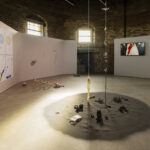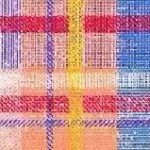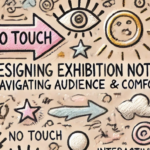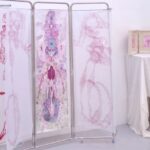In the process of planning the exhibition, I initially planned to introduce an Augmented Reality (AR) interactive experience to enhance audience participation and immersion. However, after in-depth research and practical feedback, I decided to abandon this option. Below are the reasons for my decision, along with relevant research support.
Initial research feedback with peers
In an exchange with a fellow digital media student at the University of the Arts London (UAL), she expressed her reservations about the use of AR technology in the exhibition. She expressed her reservations about the use of AR technology in the exhibition, arguing that forcing visitors to use mobile phones to scan the QR code manipulation could disrupt the continuity of the viewing experience and cause unnecessary distractions. Even if dedicated devices were provided in the exhibition space, its overall viewing experience would not be significantly improved. This view prompted me to reflect on the true purpose of interactive technology: interaction is not the ultimate goal of curation, but the quality and feeling of the audience’s experience is the core.
Refining My AR Vision: From Speculation to Prototype
In earlier reflections, I outlined several practical challenges surrounding the AR-guided exhibition model I had envisioned—ranging from technical development and budget feasibility to the risk of audience distraction. These concerns remain valid. However, following our group discussions and Adam Benmakhlouf’s lecture on Publishing as Curating (Week 9), I began to reconceptualise AR not as a novelty or navigation tool, but as a discursive and embodied curatorial method—a form of “publishing” that brings invisible processes into public space.
More specifically, I now envision AR not as a decorative overlay, but as a way to reveal the often hidden, processual life of an artwork. Through mobile devices, visitors could scan specific works or triggers to access:
•time-lapse videos of the artist’s making process,
•hand-drawn overlays or discarded materials,
•voice notes or intimate reflections from the artist’s studio.
This approach speaks directly to the thematic core of my curatorial project The Plasticity of Life, which investigates how we are continuously shaped—by others, by environments, by emotional labour, by tools. AR becomes a way to extend the work’s temporality, allowing what is usually private to remain sensorially and affectively present. Rather than dominating the experience, it acts as a soft, relational interface that invites viewers to engage with time, memory, and transformation.
That said, implementing such a system still poses logistical questions. I am currently exploring accessible AR platforms such as Artivive or 8th Wall, to determine whether it’s feasible to build a prototype without custom development. Conceptually, I am also mapping which moments in the exhibition justify AR intervention—not as a blanket feature, but as a tool that supports plastic, emergent moments in the viewer’s journey.
This shift in perspective is informed by curatorial voices already working at the intersection of digital practice and perception. For instance, Tina Sauerlaender, co-founder of Radiance VR, argues that digital curating should not merely relocate art into virtual space, but must develop new ways of curating perception itself—how a viewer moves, senses, and remembers (Sauerlaender, 2019). Similarly, Claire Bishop critiques the dominance of spectacle in immersive media and instead calls for critical, embodied, and time-sensitive uses of technology in art (Bishop, 2012).
One project that influenced my thinking is Seeing the Invisible (2021–2023), a large-scale AR exhibition presented in botanical gardens across the globe. It embedded digital artworks in natural environments and foregrounded slow discovery, spatial exploration, and environmental context over flashy visual effects (see:seeing-the-invisible-2). These examples helped me reposition AR in my project not as technological spectacle but as a quiet publishing mechanism—a curatorial interface that materialises process, emotion, and becoming. Following Adam Benmakhlouf’s framing of publishing as care and relationality, I now imagine AR not as a screen-based distraction, but as a way of holding space for fragmented histories, embodied transformation, and shared vulnerability.
Despite this research and conceptual clarity, I have ultimately decided not to implement AR in the current iteration of my curatorial project. This was not an easy decision. AR holds tremendous potential for making invisible processes visible, for extending the temporality of the exhibition, and for building emotional intimacy between audience and artwork.
However, the more I explored AR through case studies and curatorial theory, the more I realised that its successful use requires not only technical resources, but also a dedicated infrastructure of audience engagement and sustained co-development with artists. Given my current project scale, time frame, and budget, I fear that AR would risk becoming either a distraction or a partially realised gesture—something that contradicts my core intention to curate with care, depth, and emotional attentiveness.
In many ways, choosing not to use AR is still a curatorial choice. It is a choice for slowness, for simplicity, and for maintaining the tactile, bodily, and material rhythm that The Plasticity of Life seeks to hold. I have not abandoned AR as a methodology; instead, I have archived it as a potential for future work—one that I may return to when the conditions allow for it to be implemented with full integrity.
Academic Research Support and Reflection
While research has pointed out that multi-sensory experiences in exhibitions can enhance the emotional resonance and memory of the audience (Cheng et al., 2024), the limitations of AR technology are becoming increasingly apparent. AR usually relies only on visual and auditory stimuli, ignoring the involvement of other senses (e.g., touch, smell), which tends to homogenise the viewer’s experience and lacks a complete sensory resonance. In addition, Zhou et al. (2023) point out that although AR technology can provide virtual content for hard-to-reach artworks in a non-intrusive way, this virtual enhancement may lead to the weakening of the real materiality of the artworks, which in turn affects the audience’s experience of the original emotional and aesthetic values of the works.
Discussing interaction design in curatorial practice, Murchú (2016) points out that AR technology’s reliance on devices can be an obstacle to the viewer’s experience.An (2024) goes further, arguing that artworks in AR environments are susceptible to dematerialisation, weakening the emotional impact and narrative authenticity of the art itself.Pujol and Champion (2012) also remind us that: ‘excessive media interventions may diminish the aesthetic and emotional impact of the original work’ (p. 594).
In their study of the use of AR technology in cultural heritage displays, Bekele and Champion (2019) point out that although AR can significantly increase interactivity, inappropriate use may result in viewer confusion and information overload, which ultimately undermines the overall effect of the exhibition.Liao et al. (2022) further emphasise the potential for AR technology to be distracting, resulting in the viewer focusing too much on the device interface Liao et al. (2022) further emphasise that AR technology may distract viewers’ attention, causing them to focus too much on the interface of the device rather than the artwork itself: “When using augmented reality (AR), viewers may focus too much on the interface of the device rather than on the exhibition itself, which undermines the direct interaction between the viewers and the artwork” (Liao, Yang & Zhou, 2022, p. 3). Therefore, when using AR technology, curators must carefully assess its true value to the audience experience to avoid unnecessary complexity and fragmentation of the experience (Bekele & Champion, 2019; Liao et al., 2022).
In exploring the audience orientation of curatorial practice, the importance of understanding audience needs and expectations is emphasised.Bekele & Champion (2019) point out that although AR technology can be effective in increasing interactivity, it can also cause confusion or complicate the experience for the audience if used inappropriately.Liao et al. (2022) further suggest that the use of AR in museums and art exhibitions may enhance audience engagement and may also be a disruptive factor to the audience experience: ‘When using augmented reality (AR), the audience may focus too much on the device interface rather than the exhibition itself, thus disrupting the direct interaction between the audience and the artwork’ (Liao, Yang & Zhou, 2022, p. 3 ). Therefore, curators need to carefully consider whether these technologies truly enhance the viewer experience or add unnecessary complexity and disruption (Bekele & Champion, 2019; Liao, Yang & Zhou, 2022).
On the other hand, AR requires a certain level of technical maintenance and digital equipment support that is not available to all audiences. This involves issues of accessibility and digital affirmation. Especially in exhibitions with limited budgets and where it is not possible to provide a uniform device (e.g., an iPad or headset) for every visitor, the implementation of AR is difficult.
In my curatorial projects, I focus on vulnerability, transformation, and bodily perception, and forcing AR into the exhibition would likely diminish the realism and sensory resonance I seek. While AR technology has unique value in specific contexts, it is not a universal tool and should not be used for interactive purposes at the expense of audience comfort and experiential integrity.
Conclusion
In light of the above considerations, I have decided to abandon the use of AR in the exhibition in favour of a more direct, multi-sensory interaction to ensure that the audience is fully engaged in the experience of the artwork.
References
Bishop, C., 2012. Digital Divide: Contemporary Art and New Media. Artforum, [online] Available at: https://www.artforum.com/print/201207/digital-divide-contemporary-art-and-new-media-31944 [Accessed 10 Apr. 2025].
Paul, C., 2016. Digital Art. 3rd ed. London: Thames & Hudson.
Sauerlaender, T., 2019. Curating Perception in Virtual Spaces. Radiance VR. [online] Available at: https://radiancevr.co/ [Accessed 10 Apr. 2025].
Steyerl, H., 2013. Too Much World: Is the Internet Dead? e-flux journal, [online] Available at: https://www.e-flux.com/journal/49/60004/too-much-world-is-the-internet-dead/ [Accessed 10 Apr. 2025].
Seeing the Invisible, 2021–2023. Augmented Reality Contemporary Art Exhibition. [online] Available at: https://www.seeingtheinvisible.art/ [Accessed 10 Apr. 2025].
Goethe-Institut, 2022. (Un)Commoning Voices & (Non)Communal Bodies. [online] Available at: https://www.goethe.de/ins/us/en/kul/mag/22955068.html [Accessed 10 Apr. 2025].
Cliffe, L., Mansell, J., Cormac, J., Greenhalgh, C. and Hazzard, A., 2024. The Audible Artefact: Promoting Cultural Exploration and Engagement with Audio Augmented Reality. arXiv preprint arXiv:2412.08676. Available at: https://arxiv.org/abs/2412.08676 [Accessed 29 Mar. 2025].
Zhou, A.L., Zhang, K. and Yip, D., 2023. Painterly Reality: Enhancing Audience Experience with Paintings through Interactive Art. arXiv preprint arXiv:2312.01067. Available at: https://arxiv.org/abs/2312.01067 [Accessed 29 Mar. 2025].
Pujol, L. and Champion, E., 2012. Evaluating presence in cultural heritage projects. International Journal of Heritage Studies, 18(1), pp.83–102. doi:10.1080/13527258.2011.590817.
Cheng, Y., Lin, X., Xu, J. and Pan, Y., 2024. Multisensory exhibition design and emotional engagement: A study of immersive museum experiences. Journal of Exhibition and Experience Design, 12(1), pp.45–60.
An, R. (2024). Art curation in virtual spaces: The influence of digital technology in redefining the aesthetics and interpretation of art. Humanities, Arts and Social Sciences Studies, 24(2), 503–518.
Murchú, N.O. (2016). A Designerly Way of Curating: Reflecting on Interaction Design Methods for Curatorial Practice. In Curating the Digital (pp. 9–19). Springer, Cham.
Neddermeyer, I. (2018). I Want to See How You See: Curatorial Practices of Exhibiting Virtual Reality. MediaRep.
Curating for Whom? (2018). OnCurating Journal, (37), 6–13.
Bekele, M.K. & Champion, E., 2019. A Comparison of Immersive Realities and Interaction Methods: Cultural Heritage Applications in VR and AR. Cham: Springer International Publishing. Available at: https://link.springer.com/chapter/10.1007/978-3-319-28722-5_2 (Accessed: 28 March 2025).
Liao, T., Yang, S. & Zhou, J., 2022. Exploring User Experience of Augmented Reality in Museums: Enhancing or Distracting? In ACM CHI Conference Proceedings. New York: ACM Press. Available at: https://dl.acm.org/doi/abs/10.1145/3574131.3574438 (Accessed: 28 March 2025).






